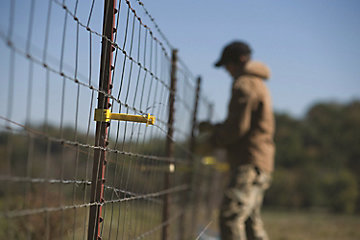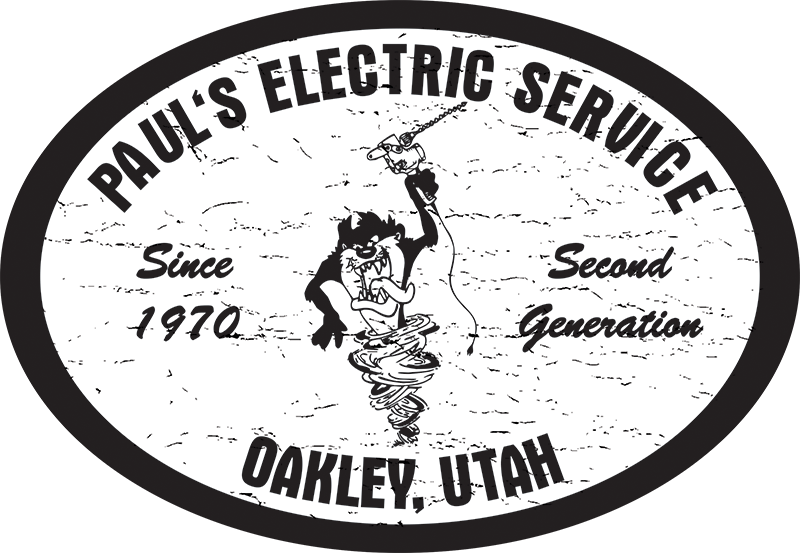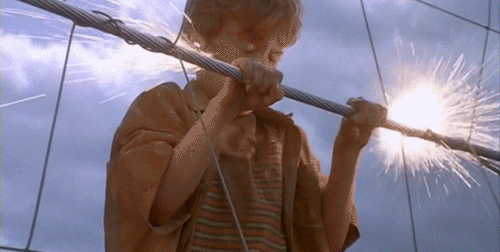Across the street from my Elementary school was a small farm with an electric fence surrounding the perimeter. During recess many of us kids would dare eachother to go and touch the fence. Of course my only exposure to electric fences at that time was from the move Jurassic Park. If you’ve seen the movie you can probably guess I was pretty terrified to touch an electric fence. Well eventually I gained the courage and touched the fence, only to feel a small pulsating tingle. So since we are in a large farming community, and subsequently have many electric fences in the area the question arises: Are Electric Fences dangerous?!
Touching an electric fence leaves a vivid and painful memory and the voltages are also high in comparison with standard mains electricity, because of this most will assume that the risk to life and limb must also be high. In fact, the opposite is true. Consider that hundreds of thousands of people throughout the world are “exposed” to the millions of electric fences every day—yet electric fences account for (but are not always the cause of) less than one serious injury per year worldwide. Compare that to the number of annual injuries and deaths that occur from human exposure to tractors, skid loaders, ladders, PTO shafts, balers, mowers, combines, bulls, stallions, shotguns, knives, etc. This is not to suggest that there is no risk. There is, indeed, a small level of risk. And with risk, there is also liability to the fence’s owner.
The voltage being sent through the wires is high, but the current or amplification (amps) is very low. A 220 volt or a 110 volt shock will hurt just as much as a 10,000-volt shock, as long as the current or amps are the same. These currents are constant and have high amperages (13 and 20 Amps) to power machinery and utensils. Muscles – human & animal – will tense up when coming in contact with 220 or 120v and are well grounded in dew or a good ground. There is no way to release from the fence in that case. You are just physically clamped on to the wire, and try as you might, you can’t let go – the steady voltage keeps your muscle locked and with the high current – You will fry.
Amps are what kills. Voltage gets your attention – it hurts.

Electric fence energizers put out high voltage (around 8,000 volts) this makes a very clear spark that really gets the attention of the target. However they also reduce the deadly amps to a very low amperage of around 120 milliamps (It varies with manufacturers). This is 120 Thousands of an Amp ( normal mains electricity is 13 Amps). It should not even kill a squirrel.
This output is made safe in two ways, firstly by releasing the flow of electrons from the capacitor in regular pulses of about 1/300th of a second approximately a second apart. The amperage component of the electrical charge is greatly reduced to figures in the range of 15 – 500milliamps. (The majority of units operate in the 100-150milliamp range)*. Compare this with two other scenarios.
- Static Electricity when you touch a door, about 30000 volts at .5 milliamps for 1/1000th. of a second, unpleasant but not lasting.
- Mains Electricity. 220volts at 13 Amps and constant, unpleasant and regularly causes death, there are many incidences of people running out wires directly plugged into 220v or 110v circuits killing both animals and people.
Modern fence energizers use low impedance circuitry, in which a capacitor is charged by a solid-state circuit. If an animal (or a person) comes into contact with the fence, the charge is released by a thyristor. This is an electronic component which can be thought of as an automatic switch so the voltage delivered is more controlled, and the shock pulse is much shorter – typically just a few milliseconds. The energy pulses through the wires or conductors. This means once every second for 1/300th of a second it sends a pulse of electricity down the line.
The reason for the pulsating current is that when the wires are touched and deliver a shock – whatever touches it has a chance to remove itself because when an animal touches an electrical wire, it causes a muscle contraction in the animal that is similar to what humans feel as a muscle cramp. With a continuous supply of current as you get with mains electricity this results in the grabbing effect that is so dangerous and the victim is unable to release the source of the current. With the pulsing of an electric fence this cramping is transitory and the victim is able to retreat from the source of energy. The animal will associate this unpleasant feeling with touching the fence and will be discouraged from touching it again in the future.
If the current did not pulse (like most electrical appliances – hair dryer, radio, toaster, etc.), then whatever touched it would continue to be shocked until the power went out or something pried them off.
With low amps and a pulsating current, electrical fencing is a safe product. It is the amperage within the electrical charge and the constant connection that makes electricity dangerous.
The one issue may occur if an animal gets trapped in the fence for a period of time and is unable to extricate itself. This could be as a result of animals with horns, hedgehogs that roll up into a ball or any other reason they have become trapped. This varies for different animals and unfortunately can result in the death of the animal. Fortunately this is very rare and in my 30 years of working with electric fencing I know of 3 incidences where an animal has been killed. For this reason, the horismart energisers has been developed that are able to recognise what is touching the fence, treat it accordingly so increasing the safety accordingly.
What NOT to do!
- Never Place your head near an electrified wire. Accidental head or neck contact can occur when pushing a voltage probe into the soil or when checking voltage. Be very careful when you do so to avoid head-to-wire contact!
- Never allow anyone else to touch a modern electric fence. It is not a game!
What to do!
- Instruct all visitors and children to never touch electric fencing
- The legislation that applies in Europe to fences accessible to the general public stipulates that an internationally recognised warning sign be displayed at the beginning and end of a fence and at every 50 meters interval

